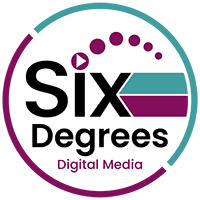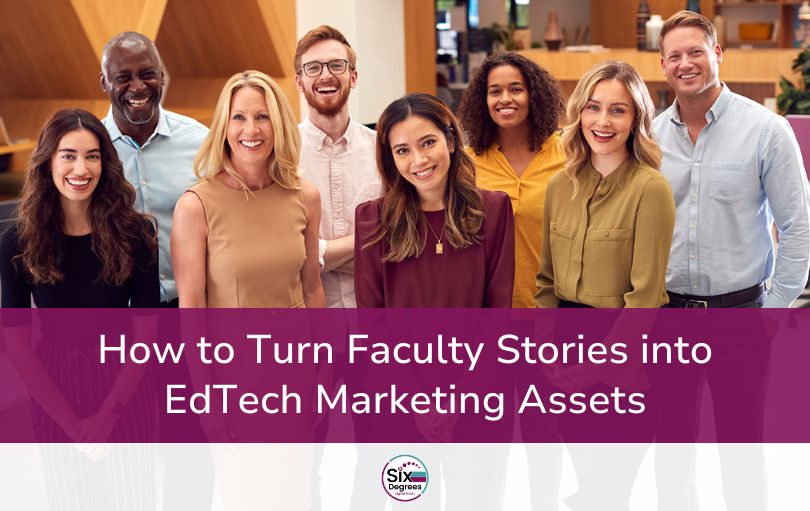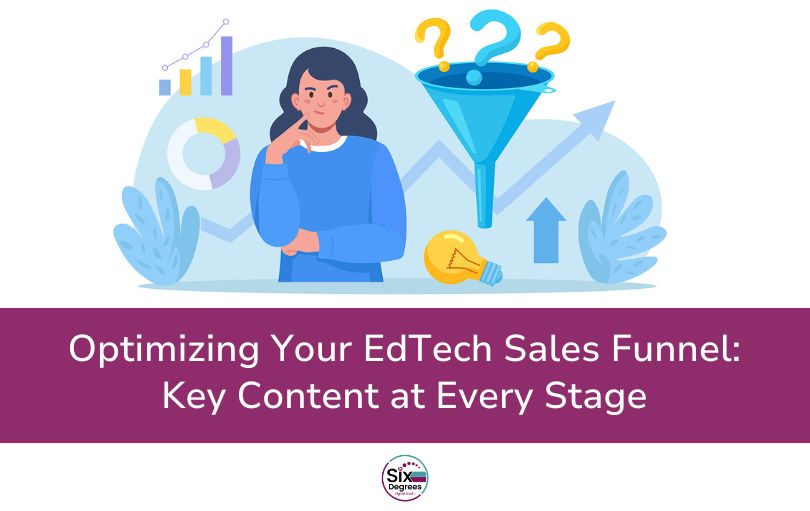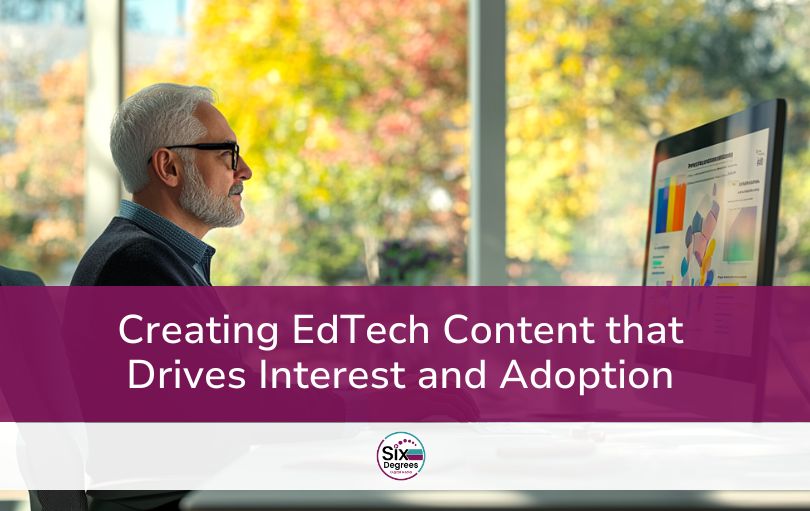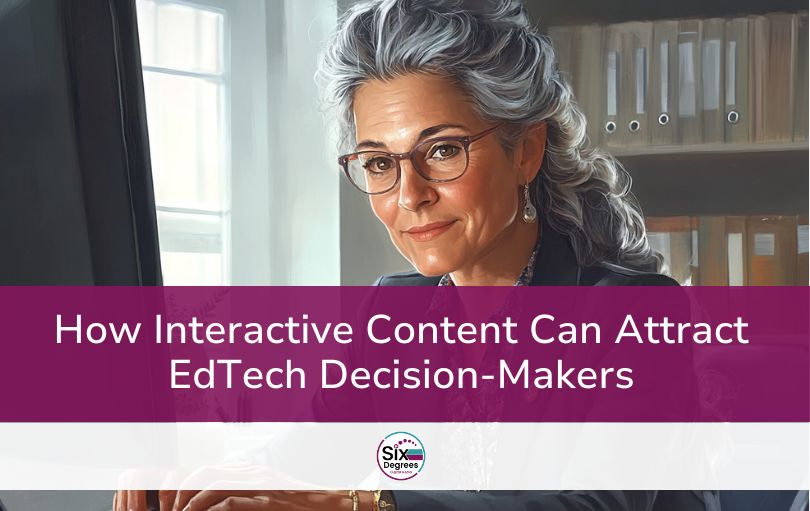Faculty play a central role in shaping student experiences, yet their voices are often overlooked in EdTech marketing. While many EdTech brands focus on showcasing product features, they miss a critical opportunity, leveraging faculty stories to highlight real-world impact.
Imagine an administrator weighing EdTech solutions for their institution. Product specs and feature lists can only go so far, but hearing how a professor improved student engagement or cut grading time in half makes the decision more tangible. Faculty experiences add authenticity, demonstrating not just what the technology does, but how it transforms teaching and learning.
The problem? Many EdTech companies fail to collect and present these stories in a way that resonates. Without a structured approach, faculty testimonials can feel generic, unpolished, or disconnected from key decision-makers.
In this guide, we’ll break down how to identify, refine, and strategically use faculty stories to build credibility, engage both educators and administrators, and ultimately drive more conversions. Whether for social media, case studies, or live demos, well-crafted faculty narratives can turn passive interest into confident action.
Why Faculty Stories Are
Powerful Marketing Tools
Faculty stories do more than highlight product features. They bring real-world validation to EdTech solutions by showcasing their impact in classrooms. Instead of just stating that a platform streamlines grading or improves engagement, faculty stories demonstrate those results through firsthand experiences, making the benefits more tangible and relatable.
A well-crafted faculty story builds a human connection. Administrators and educators are more likely to trust insights from their peers than a traditional sales pitch. When faculty members share how an EdTech tool has transformed their workflow, improved student outcomes, or reduced administrative burdens, their experiences carry weight with decision-makers.
The most effective faculty stories combine storytelling with data. A professor explaining how a learning management system helped increase student participation is powerful. Pair that with measurable results—like a 30% rise in discussion board engagement—and the story becomes even more persuasive.
Faculty voices can also encourage administrator buy-in. While decision-makers ultimately approve EdTech purchases, faculty members are the ones using the technology daily. When they advocate for a tool’s effectiveness, administrators gain confidence that their investment will be well-received and successfully implemented.
Key Takeaway:
Faculty stories add authenticity and depth to marketing. By blending real experiences with compelling data, EdTech companies can build credibility, engage multiple stakeholders, and drive stronger purchasing decisions.
How to Identify the Right Faculty Stories
Not all faculty experiences will resonate equally with your audience. The best stories highlight transformation, showing real before-and-after scenarios that illustrate how your EdTech solution makes a difference. Finding the right stories means focusing on impact, diversity, and authenticity.
Start by looking for high-impact experiences. Faculty members who have seen clear benefits—like increased student engagement, reduced administrative workload, or improved learning outcomes—provide the strongest narratives. Their insights go beyond general praise, demonstrating real, measurable success.
Diversity in experience matters. Featuring faculty from various departments, backgrounds, and levels of tech proficiency ensures your marketing resonates with a broader audience. A professor in a STEM field might emphasize data analytics features, while a liberal arts instructor may highlight collaborative learning tools. Showcasing a mix of perspectives makes your messaging more inclusive and relatable.
Your best stories may already be waiting for you. Leverage existing user feedback from surveys, customer support interactions, or online discussions. A faculty member who raved about your platform in a webinar or support ticket may be the perfect candidate for a case study or testimonial.
Key Takeaway:
The most compelling faculty stories showcase real transformation. Prioritizing stories with measurable impact and diverse perspectives ensures that your messaging connects with educators and decision-makers alike.
Where to Use Faculty Stories in Marketing
A compelling faculty story is a versatile asset that can be repurposed across multiple marketing channels to maximize engagement and influence decision-makers. By strategically placing these stories where they will have the greatest impact, EdTech companies can strengthen their messaging and build deeper trust with both administrators and educators.
Website & Landing Pages – Faculty success stories add credibility when featured on product pages, landing pages, or dedicated testimonial sections. A well-placed quote or case study can reinforce why your solution is a must-have for institutions.
Social Media & Video Content – Short-form video testimonials, faculty Q&A clips, and quote graphics can grab attention on LinkedIn, Instagram, and YouTube. These snippets make complex solutions feel more relatable and engaging.
Webinars & Case Studies – Faculty members sharing their experiences in live or recorded webinars provide authentic, high-value content. Case studies offer a deeper dive into real-world applications and measurable outcomes, making them a strong asset for lead nurturing.
Sales & Email Campaigns – Personal stories woven into email sequences help nurture leads and build trust. Faculty testimonials in sales presentations make pitches feel less sales-driven and more experience-based.
Encouraging Faculty to Participate in Demos – Since administrators make purchasing decisions, it’s easy to overlook faculty input. However, including faculty advocates in product demonstrations can provide real-world validation and strengthen administrator buy-in. When decision-makers see faculty enthusiasm firsthand, they are more likely to commit.
[Download our cheat sheet: How to Drive More Sales with Your EdTech Demo]
Key Takeaway:
Faculty stories become even more powerful when repurposed across different marketing touchpoints. By integrating them into web content, social media, webinars, and sales efforts, EdTech companies can amplify their impact and create deeper connections with prospective buyers.
Common Mistakes & How to Avoid Them
Faculty stories can be powerful marketing assets, but when used incorrectly, they lose their impact. To ensure these stories resonate with decision-makers and drive engagement, EdTech companies must avoid common pitfalls.
Making It All About the Product – The best faculty stories aren’t just about how great a tool is, they’re about how it changes an educator’s experience. Instead of focusing on product features, highlight how a professor overcame challenges, improved student engagement, or streamlined their workload. A relatable, problem-solving narrative is far more compelling than a list of technical specs.
Skipping Data – Emotional storytelling is effective, but pairing it with measurable results makes it even stronger. A professor saying, “This software transformed my classroom” is good, but adding “and improved student retention by 22%” makes the claim undeniable. Balance qualitative insights with quantitative proof to add credibility.
Not Getting Permission – Faculty trust is key. Always obtain written consent before featuring an educator’s story in marketing materials. Whether it’s a direct testimonial, case study, or video feature, ensure transparency and alignment with their institution’s policies.
Overlooking the Faculty-Administrator Connection – Administrators may control budgets, but faculty members influence decisions. Including faculty perspectives in sales presentations or demos helps bridge the gap between educator needs and administrative priorities. When faculty advocates champion a product, administrators are more likely to buy in.
Key Takeaway:
A well-balanced faculty story weaves together emotion, data, and ethical storytelling. By centering real experiences, securing proper permissions, and integrating faculty voices into the sales process, EdTech companies can create compelling narratives that drive engagement and credibility.
Moving Forward
Faculty stories are one of the most underutilized yet powerful assets in EdTech marketing. When done right, they go beyond testimonials and create compelling narratives that showcase real-world impact, build trust, and drive decision-making.
Even a few well-crafted faculty success stories can make a difference—helping administrators see the value of your solution through the lens of those who use it daily. By collecting authentic experiences, pairing them with measurable results, and integrating them across multiple marketing channels, EdTech companies can create content that resonates and influences purchasing decisions.
Need help incorporating faculty stories into your EdTech marketing? Let’s build a strategy that connects with educators and decision-makers alike. Contact us today.
